Page 295 of 347
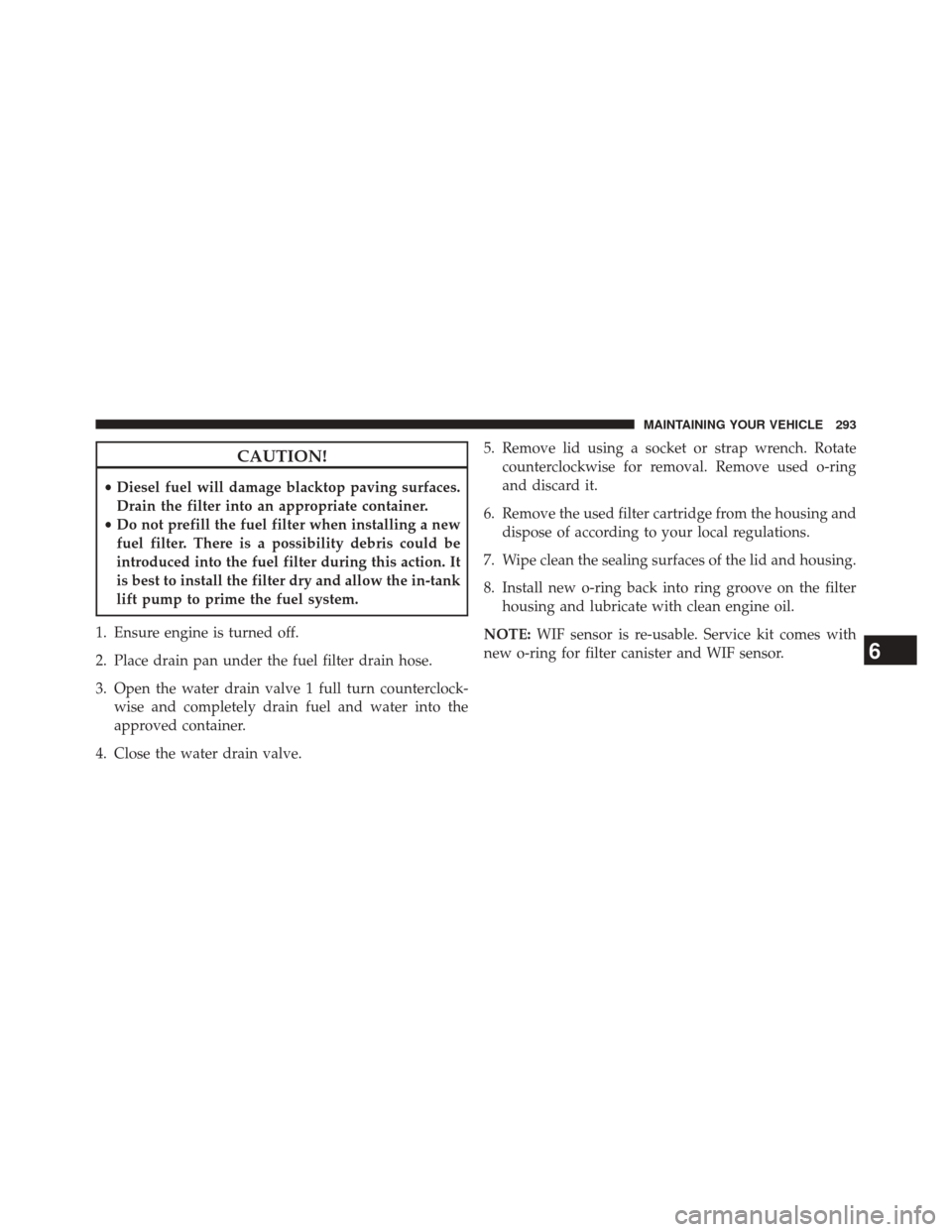
CAUTION!
•Diesel fuel will damage blacktop paving surfaces.
Drain the filter into an appropriate container.
• Do not prefill the fuel filter when installing a new
fuel filter. There is a possibility debris could be
introduced into the fuel filter during this action. It
is best to install the filter dry and allow the in-tank
lift pump to prime the fuel system.
1. Ensure engine is turned off.
2. Place drain pan under the fuel filter drain hose.
3. Open the water drain valve 1 full turn counterclock- wise and completely drain fuel and water into the
approved container.
4. Close the water drain valve. 5. Remove lid using a socket or strap wrench. Rotate
counterclockwise for removal. Remove used o-ring
and discard it.
6. Remove the used filter cartridge from the housing and dispose of according to your local regulations.
7. Wipe clean the sealing surfaces of the lid and housing.
8. Install new o-ring back into ring groove on the filter housing and lubricate with clean engine oil.
NOTE: WIF sensor is re-usable. Service kit comes with
new o-ring for filter canister and WIF sensor.
6
MAINTAINING YOUR VEHICLE 293
Page 296 of 347
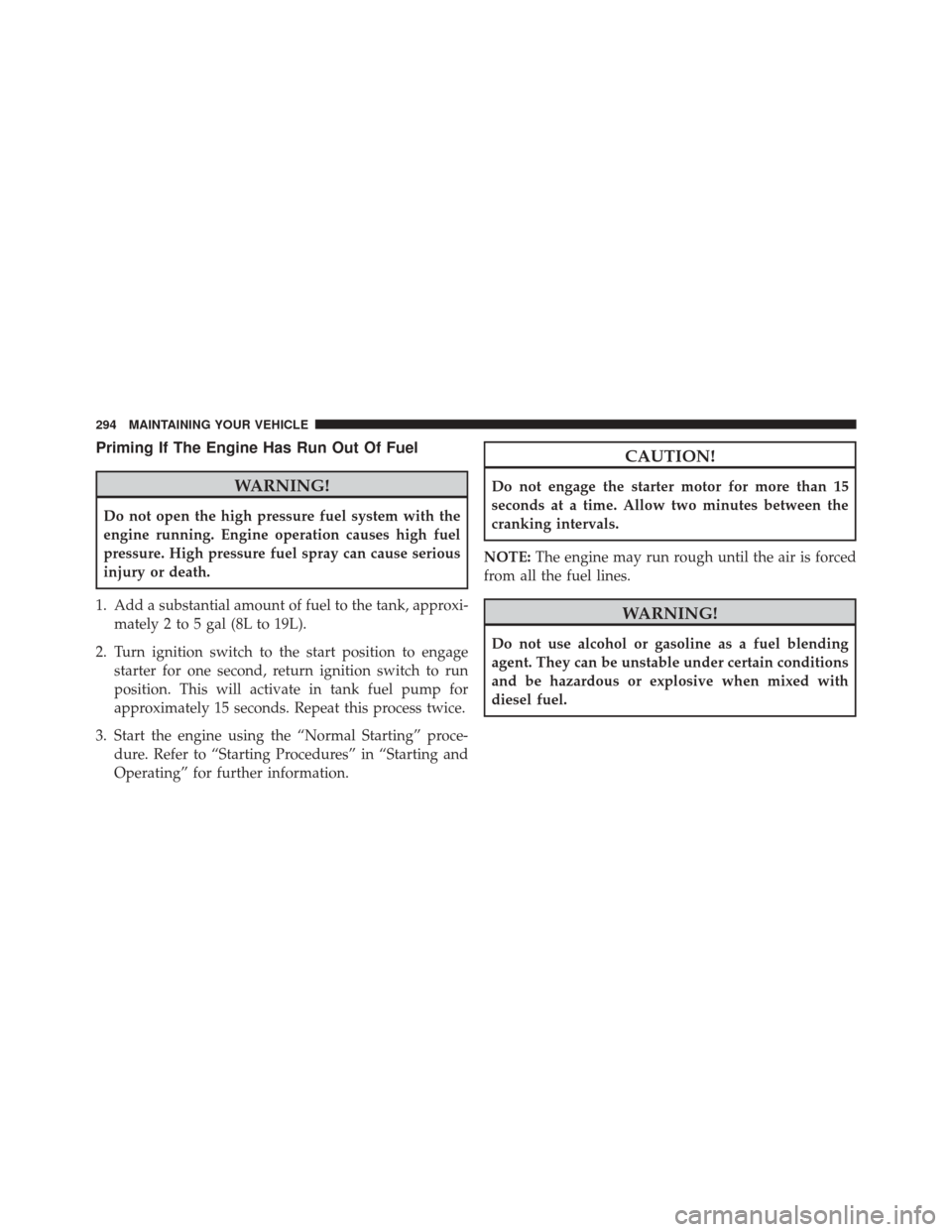
Priming If The Engine Has Run Out Of Fuel
WARNING!
Do not open the high pressure fuel system with the
engine running. Engine operation causes high fuel
pressure. High pressure fuel spray can cause serious
injury or death.
1. Add a substantial amount of fuel to the tank, approxi- mately 2 to 5 gal (8L to 19L).
2. Turn ignition switch to the start position to engage starter for one second, return ignition switch to run
position. This will activate in tank fuel pump for
approximately 15 seconds. Repeat this process twice.
3. Start the engine using the “Normal Starting” proce- dure. Refer to “Starting Procedures” in “Starting and
Operating” for further information.
CAUTION!
Do not engage the starter motor for more than 15
seconds at a time. Allow two minutes between the
cranking intervals.
NOTE: The engine may run rough until the air is forced
from all the fuel lines.
WARNING!
Do not use alcohol or gasoline as a fuel blending
agent. They can be unstable under certain conditions
and be hazardous or explosive when mixed with
diesel fuel.
294 MAINTAINING YOUR VEHICLE
Page 297 of 347
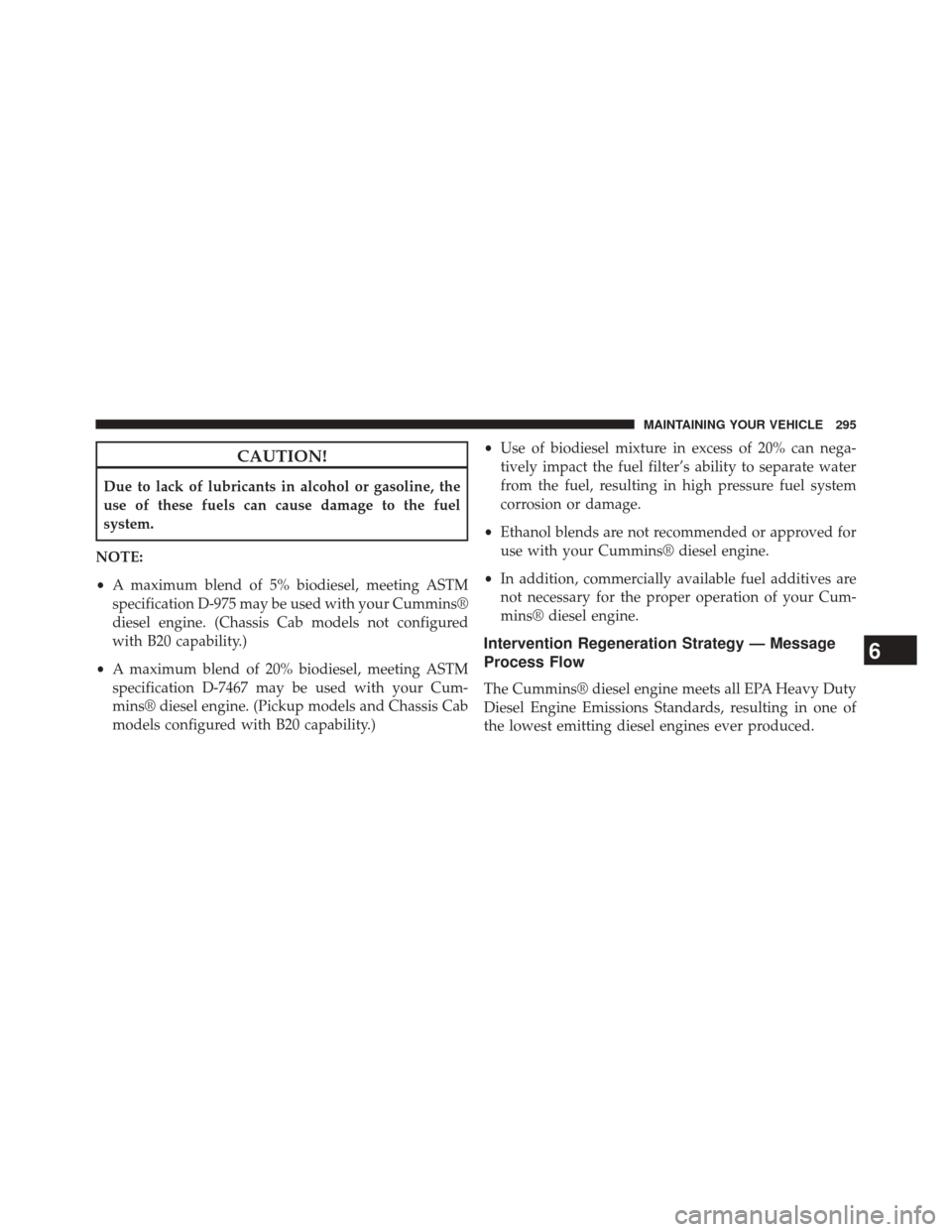
CAUTION!
Due to lack of lubricants in alcohol or gasoline, the
use of these fuels can cause damage to the fuel
system.
NOTE:
• A maximum blend of 5% biodiesel, meeting ASTM
specification D-975 may be used with your Cummins®
diesel engine. (Chassis Cab models not configured
with B20 capability.)
• A maximum blend of 20% biodiesel, meeting ASTM
specification D-7467 may be used with your Cum-
mins® diesel engine. (Pickup models and Chassis Cab
models configured with B20 capability.) •
Use of biodiesel mixture in excess of 20% can nega-
tively impact the fuel filter’s ability to separate water
from the fuel, resulting in high pressure fuel system
corrosion or damage.
• Ethanol blends are not recommended or approved for
use with your Cummins® diesel engine.
• In addition, commercially available fuel additives are
not necessary for the proper operation of your Cum-
mins® diesel engine.
Intervention Regeneration Strategy — Message
Process Flow
The Cummins® diesel engine meets all EPA Heavy Duty
Diesel Engine Emissions Standards, resulting in one of
the lowest emitting diesel engines ever produced.
6
MAINTAINING YOUR VEHICLE 295
Page 305 of 347
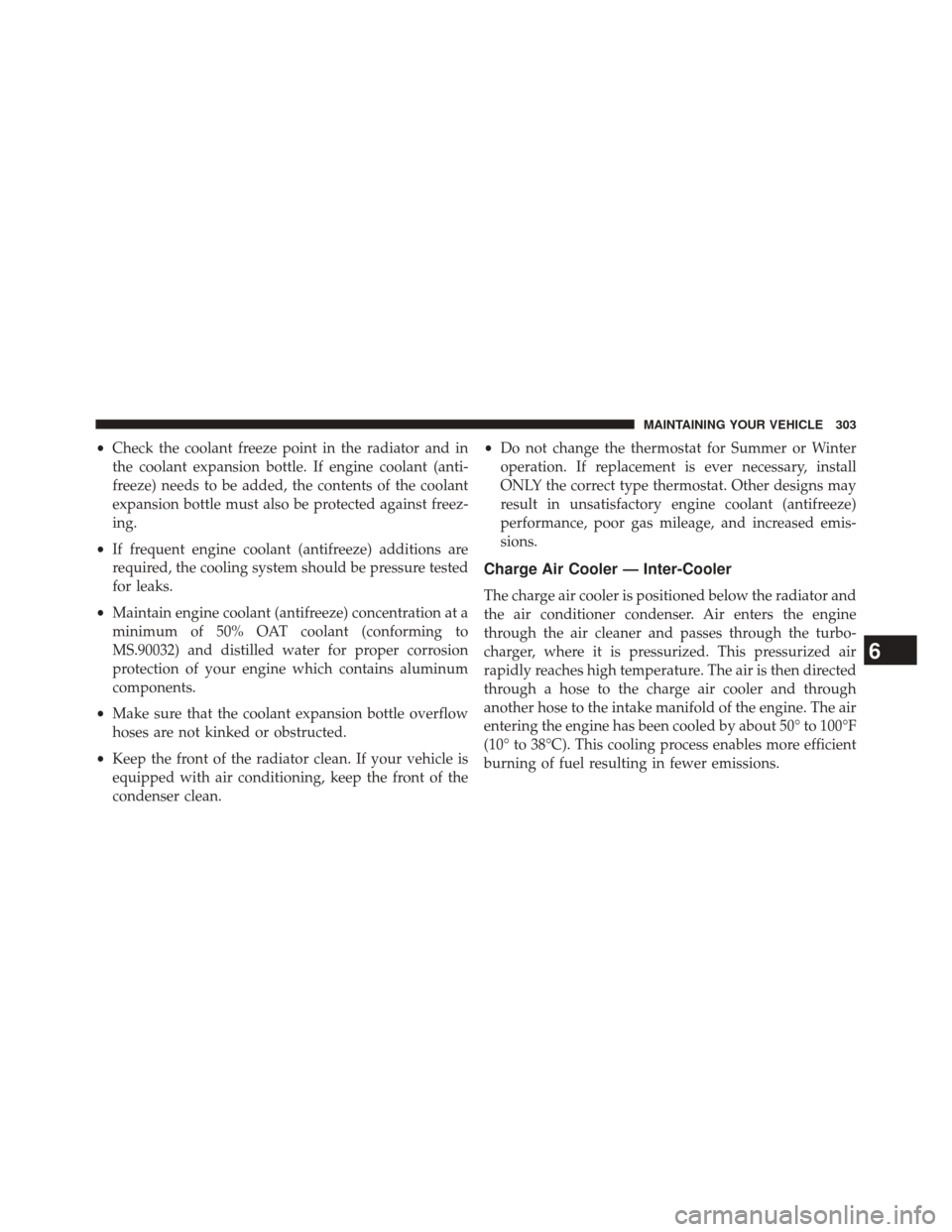
•Check the coolant freeze point in the radiator and in
the coolant expansion bottle. If engine coolant (anti-
freeze) needs to be added, the contents of the coolant
expansion bottle must also be protected against freez-
ing.
• If frequent engine coolant (antifreeze) additions are
required, the cooling system should be pressure tested
for leaks.
• Maintain engine coolant (antifreeze) concentration at a
minimum of 50% OAT coolant (conforming to
MS.90032) and distilled water for proper corrosion
protection of your engine which contains aluminum
components.
• Make sure that the coolant expansion bottle overflow
hoses are not kinked or obstructed.
• Keep the front of the radiator clean. If your vehicle is
equipped with air conditioning, keep the front of the
condenser clean. •
Do not change the thermostat for Summer or Winter
operation. If replacement is ever necessary, install
ONLY the correct type thermostat. Other designs may
result in unsatisfactory engine coolant (antifreeze)
performance, poor gas mileage, and increased emis-
sions.
Charge Air Cooler — Inter-Cooler
The charge air cooler is positioned below the radiator and
the air conditioner condenser. Air enters the engine
through the air cleaner and passes through the turbo-
charger, where it is pressurized. This pressurized air
rapidly reaches high temperature. The air is then directed
through a hose to the charge air cooler and through
another hose to the intake manifold of the engine. The air
entering the engine has been cooled by about 50° to 100°F
(10° to 38°C). This cooling process enables more efficient
burning of fuel resulting in fewer emissions.
6
MAINTAINING YOUR VEHICLE 303
Page 317 of 347
FLUID CAPACITIES
U.S.Metric
Fuel (Approximate)
2500/3500 Standard Cab Longbed Models 28 Gallons 106 Liters
2500/3500 Crew/Mega Cab Shortbed Models 31 Gallons 129 Liters
2500/3500 Crew Cab Longbed Models 32 Gallons 132 Liters
Standard Rear Tank – Chassis Cab Only 52 Gallons 197 Liters
Optional Midship Tank – Chassis Cab Only 22 Gallons 83 Liters
Diesel Exhaust Fluid Tank (Approximate) – 2500/3500 Models 5.5 Gallons 21 Liters
Diesel Exhaust Fluid Tank (Approximate) – Chassis Cab 9 Gallons 34 Liters
Engine Oil With Filter
6.7L Turbo Diesel Engine 12 Quarts 11.4 Liters
Cooling System
6.7L Turbo Diesel Engine (MOPAR® Engine Coolant/Antifreeze 10 Year/
150,000 Mile Formula) 5.7 Gallons 21.4 Liters
6
MAINTAINING YOUR VEHICLE 315
Page 318 of 347

FLUIDS, LUBRICANTS AND GENUINE PARTS
Engine
ComponentFluid, Lubricant, or Genuine Part
Engine Coolant We recommend you use MOPAR Antifreeze/Coolant 10 Year/150,000 Mile Formula OAT (Organic Additive Technology).
Engine Oil In ambient temperatures above 0°F (-18°C), we recommend you use 15W-40 engine oil such
as MOPAR, Shell Rotella and Shell Rimula that meets FCA US Material Standard MS-10902
and the API CJ-4 engine oil category is required. Products meeting Cummins CES 20081
may also be used. The identification of these engine oils is typically located on the back of
the oil container.
In ambient temperatures below 0°F (-18°C), we recommend you use 5W-40 synthetic
engine oil such as MOPAR, Shell Rotella and Shell Rimula that meets FCA US Material
Standard MS-10902 and the API CJ-4 engine oil category is required.
Engine Oil Filter We recommend you use MOPAR Engine Oil Filters.
Fuel Filters We recommend you use MOPAR Fuel Filter. Must meet 3 micron rating. Using a fuel filter
that does not meet the manufacturers filtration and water separating requirements can
severely impact fuel system life and reliability.
316 MAINTAINING YOUR VEHICLE
Page 319 of 347
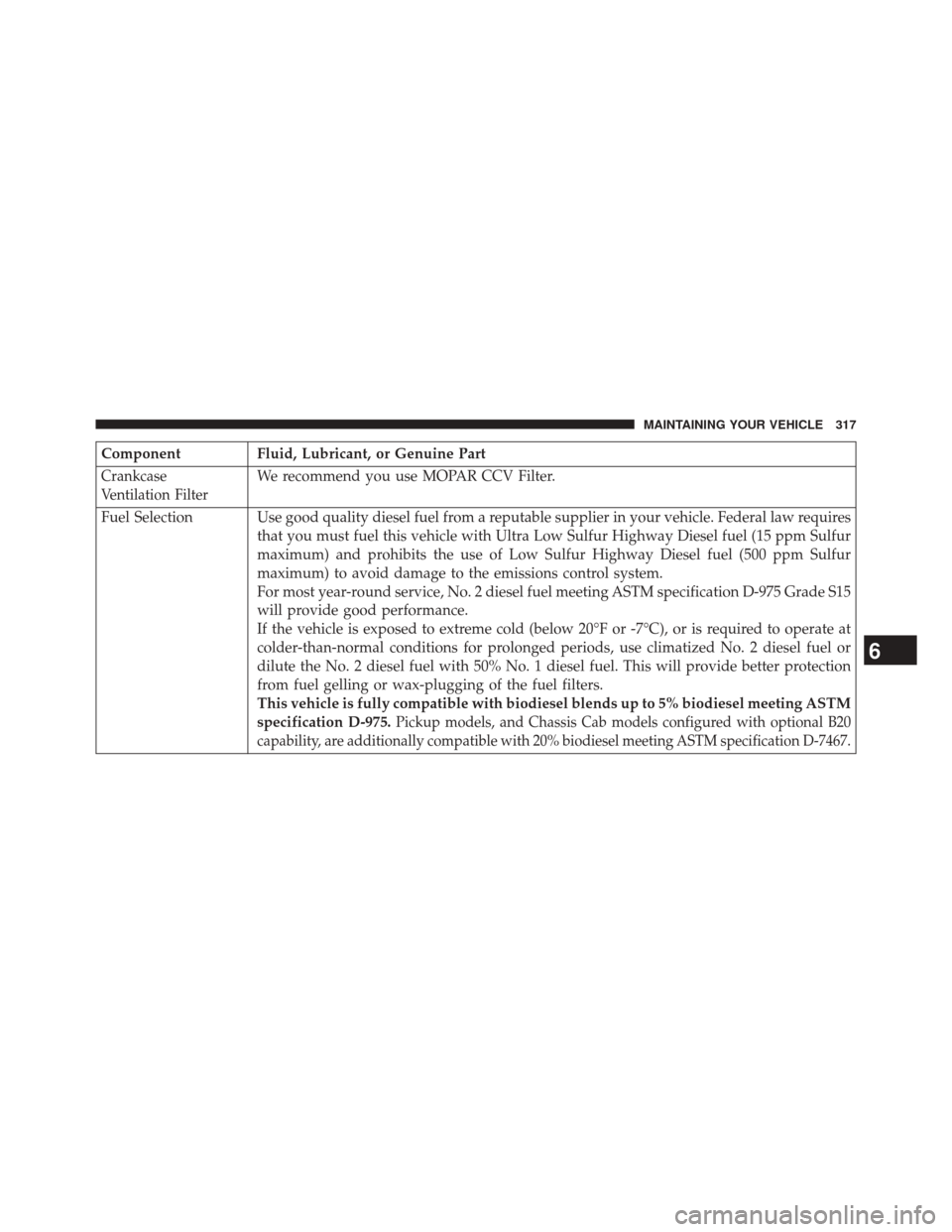
ComponentFluid, Lubricant, or Genuine Part
Crankcase
Ventilation FilterWe recommend you use MOPAR CCV Filter.
Fuel Selection Use good quality diesel fuel from a reputable supplier in your vehicle. Federal law requires that you must fuel this vehicle with Ultra Low Sulfur Highway Diesel fuel (15 ppm Sulfur
maximum) and prohibits the use of Low Sulfur Highway Diesel fuel (500 ppm Sulfur
maximum) to avoid damage to the emissions control system.
For most year-round service, No. 2 diesel fuel meeting ASTM specification D-975 Grade S15
will provide good performance.
If the vehicle is exposed to extreme cold (below 20°F or -7°C), or is required to operate at
colder-than-normal conditions for prolonged periods, use climatized No. 2 diesel fuel or
dilute the No. 2 diesel fuel with 50% No. 1 diesel fuel. This will provide better protection
from fuel gelling or wax-plugging of the fuel filters.
This vehicle is fully compatible with biodiesel blends up to 5% biodiesel meeting ASTM
specification D-975.
Pickup models, and Chassis Cab models configured with optional B20
capability, are additionally compatible with 20% biodiesel meeting ASTM specification D-7467.
6
MAINTAINING YOUR VEHICLE 317
Page 324 of 347
MAINTENANCE SCHEDULE — DIESEL ENGINE
CAUTION!
Failure to perform the required maintenance items
may result in damage to the vehicle.
At Each Stop For Fuel
Check the engine oil level at least 30 minutes after a fully
warmed engine is shut off. Checking the oil level while
the vehicle is on level ground will improve the accuracy
of the oil level reading. Add oil only when the level is at
or below the ADD or MIN mark. Once A Month
•
Inspect the batteries, and clean and tighten the termi-
nals as required.
• Check the fluid levels of the coolant reservoir, brake
master cylinder, and automatic transmission (if
equipped), and add as needed.
At Each Oil Change
• Change the engine oil filter.
• Inspect the exhaust system.
• Inspect engine air filter.
• Check the coolant level, hoses, and clamps.
• Lubricate outer tie rod ends.
322 MAINTENANCE SCHEDULE